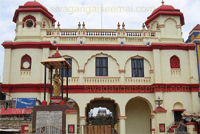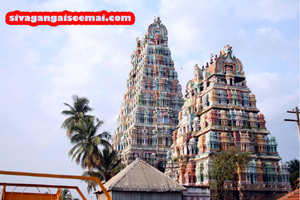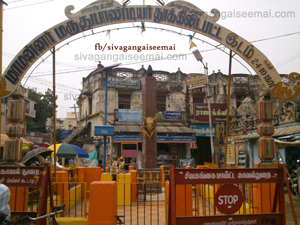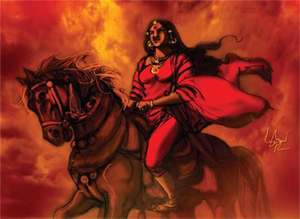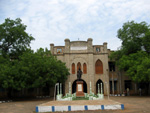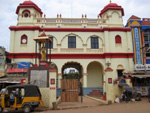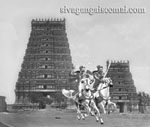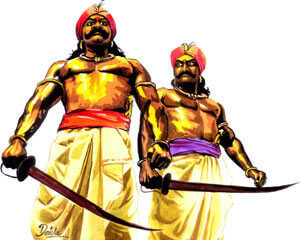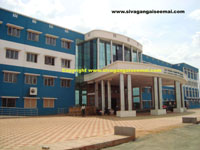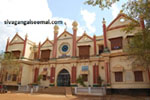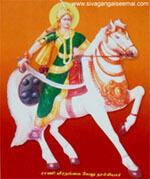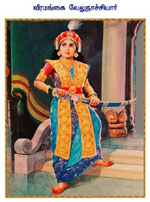Proclamation of Edward Lord Clive dated 6 th July 1801
1) Sheshavarna Tevar, distinguished by his personal merit was raised to the rank of Zemindar as the reward of his services and was the first Zemindar of Shevagungah, he was succeeded in the possession of that Zemindary by his only son, Vullaganatha Taver, who was killed in the battle at Collaye coil. The widow of Vullaganad Taver, having escaped with their only child, a daughter was subsequently restored to the possession of the Zemindary by her sovereign the Nawab of the Carnatic. The daughter of Vullaganada Taver was married to Vengam Perria Worria Taver to whom she bore an only daughter. That daughter died. The daughter of Vullaganada Taver without bearing issue, and her mother, as well as the widow of Vullanganada Taver, having also demised, it follows that no line descendant from first Zemindar of Shevagungah, Shesawarna Taver, now exists. The hereditary right of succession to that Zemindary, therefore, extinct, and the Zemindary of Shevagungah, upon the principles on which it was erected into a Zemindary, has positively, escheated, the state from which it derives its protection.
2. The Zemindary of Shevagungah being dependent on the Carnatic payenghant, the princes, nobles and inhabitants of that Zemindary owed allegiance to the Nawab of the Carnatic, but the first Zemindar, having been expressly appointed by the Naboob Saad Ally Khan, and advanced by those means to the rank of a feudal lord, Sheshavarna Taver, and his descendants owed, in a particular manner, legiance and obediance to the Naboob and his successors, Sovereigns of the Carnatic. By virtue of the connection long established between the Naboob’s sovereign of the Carnatic and the British nation, the protection of the Carnatic and its dependencies has been committed to the armies of the Honourable Company, and by the express stipulations of an exercising treaty dated 12 th July 1792, all power and control over the poligar countries, including the Zemindary of Shevagungah, as well as the right of levying receiving appropriating the peishcush, or tribute from the Zemindars and polygars of those countries, were formally and perpetually transferred by the late Naboob Walajah to the Honourable Company. In confirmity to the rights acquired by that treaty, the Honourable Company has continued, from the date of the conclusion of the instrument, to receive the peishcush, and to exercise the authority of the Government over the poligar countries generally, and, in particular over the Zemindary of Shevagungah. By virtue therefore of the rights acquired by treaty, and by the continual exercise of legitimate Government, the Honourable Company is the lawful sovereign of the poligar countries including the Zemindary of Shevagungah, and consequently, possess the sole right of exercising its power, according to its discretion, in disposing of the escheated Zemindary of Shevagungah.
3) The actual exercise of the power of the Company has, for a time, been interrupted by the machinations of Vella Murdoo and Chinna Murdoo. Vella Murdoo and Chinna Murdoo were the servants of the House of Nalcooty at the time when the widow of Vullaganada Taver, fled with her infant daughter from Shevagungah on the return of that princess, they being her principal ministers in the administration of the affairs of Shevagungah, and availing themselves of disqualifications attendant of a feudal Government, established in their own hands an entire despotism and tyranny, as well over the princess’s lineal descendants of the House of Nalcooty, as over the collateral branches of that family, and over the inhabitants of Shevagungah.
4) Upon the death of the last lineal descendant of the House of Nalcooty, Vella Murdoo and Chinna Murdoo attempted to maintain their usurped power by force of arms, and having prevailed on some deluded inhabitants to participate in their crimes, are now actually in open rebellion, opposing resistance to the arms of the Company, and involving the country of Shevagungah in destruction and misery.
5) Wherefore the Right Honourable Edward Lord Clive, Governor in Council of Fort St George and all its dependencies having judged it expedient at this time of exercise the legitimate powers acquired to the Honourable Company in settling the affairs of the Zemindary of Shevagungah for a permanent foundation, has been pleased to nominate, appoint and constitute Permettoor Worria Taver, collaterally descended from the progenitors of Sheshavarna Taver, the first Zemindar of Shevagungah to be present Zemindar of Shevagungah and the said Governor in Council hereby requires and commands all the inhabitants of Shevagungah to respect the rights and authority of the said Permettoor Worria Taver, as the true and lawful Zemindar of Shevagungah.
6) In proceeding to exercise the right and power of nominating a Zemindar to the country of Shevagungah, the Right Honourable the Governor in Council has not been unmindful of the pretensions of Vengum Perria Worria Taver, also collaterally descended from the progenitor’s of the first Zemindar of Shevagungah Sheshawarna Taver, but the said Vengum Perria Worria Taver having united his interests with those of the rebellious slaves of his house, Vella Murdoo and Chinna Murdoo having violated the dignity of his family, and the established maxims of his religion - by receiving the daughter of Vella Murdoo in marriage, and being now actually in arms, with the said Vella Murdoo and Chinna Murdoo against the power of the Company the Right Honourable the Governor in Council of Fort St George hereby publicly and formally proclaims the disqualification of the said Vengum Perria Worria Taver, now and in all times to come, to the possession of the Zemindary of Shevagungah,
7) And whereas the flagrant rebellion of Vella Murdoo, Chinna Murdoo and Vengum Perria Worria Taver, has now rendered it necessary that a military force should be assembled for the purpose of suppressing the usurpation of the said Murdoos, and of establishing the legitimate authority of Zemindar of Shevagungah, and whereas a large army has been assembled under the command of the Lieutenant, Colonel Agnew for those purposes wherefore the Right Honourable the Governor in Council hereby proclaims to the inhabitants of Shevagungah, that his Lordship has vested in Lt Colonel Agnew, full power to punish with death, all persons who shall be found acting in arms or opposing by any other means, the authority and dignity of the British Government.
8) The inhabitants of Shevagungah cannot be ignorant that the force now assembled, under the command of Lt. Colonel Agnew, is sufficient to suppress the rebellion of Vella Murdoo and Chinna Murdoo and to substantiate the rights of the Zemindar of Shevagungah, the frequent instances of the prevalence of the Company’s power against the rebels who have recently appeared in the Southern Provinces cannot be unknown to the inhabitants of Shevagungah, and they cannot therefore expect that after the suppression of so many rebellions, of which that of the Murdoos formed a part, the said Murdoos will be available to maintain their usurpation against the power of the Company.
9) Wherefore, the said Edward Lord Clive Governor in Council of Fort St George gives this timely warning to the inhabitants of Shevagungah of the fatal consequences in which they are about to involve themselves, their families, and their country,unless they shall abandon the cause of Vella Murdoo and Chinna Murdoo, the usurpers of the rights of the lawful Zemindar of Shevagungah while the time yet allows them, to retract their error, to acknowledge their allegiance to the lawful Zemindar of Shevagungah and to resume their ordinary occupations of life, in the confident expectation of enjoying under the moderation and protection of the British Government their individual rights of property, the free administration of the laws of their religion and the full exercise of the domestic usages of their ancestors. Fort St George, 6 th July 1801 by order of the Right Honourable Governor in Council. (Signed) J. WEBBE Chief Secretary to Government (signed) G.G. KEBS Assistant to the Secretary (Signed) A.J. ARBUTHNOT Head Assistant to the Registrar.
The Resident reported the arrangements made to give publicity to the proclamation of Government announcing the appointment of Permattor Woria Tevar as Zemindar of Sivaganga -116 The Collector wrote a letter on 7th July 1801 to the Tahsildar of Palimurra about the rebel’s activities of Sivaganga. The rebels of Sivaganga attacked the pagoda and town of Tiruchuli and Col Agnew had been asked immediately to suppress them. A report about Chinna Murdoo’s conduct was sent to Lt.Col Agnew, Commanding the Southern Detachment on 13th July 1801. 1. The enormities practised by Chinna Murdoo under the protection of Hyder Ally during his usurpation of authority in Sivaganga, the barbarity of his conduct in the cruel warfare, he waged against the Rajah of Ramnad, and the intrigues and bribery by which he accomplished his sinister ends while he was under the authority of Mr. Landon and Mr. Jackson were notorious when the Collector took charge of the country. 2. The orders of the Hon’ble the Court of Directors in 1795 for disarming the refractory poligars and adjusting their disputed claims etc were carried into effect. 3. Again in 1800, Murdoo was found in league with Dhoondia and a watch was kept over his conduct. The death of Dhoondia and the nature of the transactions passing in the districts of Mr. Hurdis and captain Mc Leod, together with the presence of Runga Row and hircarrahs subverted the Shevogar’s activities. 4. The ryots of Abiramam complained at the time of the settlement of their village rents, that the Shevogar completely turned the course of the stream which had supplied their tanks for ages. After a personal inspection of the spot, the Collector warned the Shevogar. 5. The Collector summoned the Shevogar at various times to settle the claim of succession to the Zamindari, but he evaded appearing. As the rebellion of Panchalmcourchy broke out on the 2nd of the month, the Collector left Ramnad for the Pollams. He intercepted in February a letter written by a vakil whom the Shevogar had deputed to Panchalmcourchy, which manifested that a close connection subsisted between him and the rebels. 6. If the Shevogar had been impeached at that moment, his consciousness of his guilt would have driven him into rebellion. 7. It was obvious that whenever he openly threw off his allegiance, his own kist would be withheld; Ramnad and the whole of the sequestered Pollam would be thrown into distraction. 8. As it did not appear that any advantage would be gained by a public accusation of the Shevogar, before the rebels of Panchalmcourchy, the Collector lulled him into a belief that he had no suspicion of his disaffection. 9. Such were the benefits of this forbearance to the revenue; of what advantage it has been to the military operations. Lt. Col Agnew will be able to Judge. “ The enemy followed up the blockade of the Bay of Tondi with a successful attempt at the creation of dissensions within the rebel ranks. Having failed in persuading Vella Marudu to join the side of the Company against his brother Chinna Marudu, the English pomoted rivalry in the ruling house of Sivaganga. At the instance of the Company, Padamattur Woya Tevar a member of the royal family, contested the claims of Vengum Peria Wodaya Tevar, the ruler under whom the Marudus served as ministers. With this development the rebel camp was sundered into two warring factions and tormented by rivalry On top of it all, the Company scored a vital diplomatic success, when they won the support of Padamattur Voya Thevar, descendant of Sasivarna Tevar, the former ruler of Sivaganga. The Company made a capital out of the Marawa - Agambadiar conflict. In the absence of a Marawa to lead them at Sivaganga, the Marawas of the territory were giving their unstinted support to the Agambadia Servais, the Marudhus in perference to the alien powers, the Nawab and the British. Now that the Company had declared Padamattur Voya Thevar, as the chief of Sivaganga, the royalist group naturally supported Voya Thevar. Therefore, there was a split among the columns of Sivaganga
As no followers could be obtained immediately the Tondaiman hired out 250 of his peons for service with Woya Tevar. Escorted by them the traitor prince reached the camp of Blackburne at Arandangy on the 12 th of August. Eager to project the image of the rival prince, the troops of the Company accorded a pompous but patched up welcome.- “From Arandangy, Woya Tevar, accompanied by more people, proceeded to the camp of Agnew at Sivaganga. On the 12 th of September 1801 in a ceremonious function at Cholapuram the ancient capital of Sivaganga attended with much display and ostentation, deliberate though they were, Agnew installed Woya Tevar as the Rajah of the state”. The Brahmins in our camp and vicinity having fixed 12th September 1801 as an auspicious day, for the inauguration of the new Sheragar of Shevagungah, His Highness Woodia Tevar rose with the lark, adorned himself like a peacock and moved in state to the Pagoda of Sholaveram, escorted by the staff, and the 2nd battalion of the 6 th regiment; where having various religious ceremonies to perform, we left him till noon, when Colonel Agnew and staff in full costumes, proceeded with an escort of cavalry, first to Colonel Inne’s camp where he joined the cavalcade and thence to the Pagoda, at the gate of which Woodia Tevar’s tent was pitched with a temporary pandall for our reception. The embroyo diginitary having met us here, Colonel Agnew, after the customary salutation; presented with a superb dress; at the same time giving his brother a similar one, but of much less value. They then retired into the tent and shortly afterwards the cavalry having been drawn up with a Howdah elephant and military band, the great men returned, dressed in their robes of honour, when they were greeted by a concatenation of sounds, produced by our band, in conjunction with various native musical instruments; in which the war like collery horn and noisy tom-tom were the most conspicuous for execution. On their arrival at the front of the pandall Colonel Agnew- on his right, and Colonel Innes on his left handed the Rajah in and seated him on a carpet in the centre with his brother on his left hand; when our chair being placed in semicircle, we all sat down opposite to them.
All being at length adjusted, and silence obtained, a matter of considerable difficulty, a scribe read aloud the proclamation of Government announcing the appointemnt of the said’ Woodia Tevar’ to be Zameendar of the Shevagungah district’ Then handing the deed to Colonel Agnew, he folded it up and presented it, with an appropriate and congratulatory speech to the new Zameendar who expressed his gratitude in a very eloquent and feeling reply. A salute of elevan guns was then fired, and the two Colonels having handed the Prince into his Howdah (A carriage or litter of various dimensions, fitted on the back of an elephant for the accommodation of princes, or great natives; in courts, it is the state- carriage of the Sovereign the officers all remounted, and the cavalry formed an advanced and rear - guard with drawn swords, having the elephant and staff in the centre.) The procession then started, with a flourish of trumpets and a march from the band; the native music struck up, and a peal of shouts and shreiks from all the Poligars and collery attendants rent the air. After passing all round the Pagoda and camp, the cavalcade stopped at the exact spot from whence, It set out, and Woodia Taver was again handed into the pandall by the Colonels. The new Prince was actually overpowered with gratitude. I saw a tear run down his cheek, and all at once unable any longer to suppress his honest feelings, he arose threw himself at Colonel Agnew’s feet and embraced his knees whilst his brother, by a simultaneous movement and feeling embraced the knees of Colonel Innes. The scene had now become truly interesting, and I must own I felt a sensation almost amounting to regret, when it was concluded, by our taking leave and retiring. The Zameendar remained, to receive the homage of the few of his future subjects who had come over to our side and at five p.m. he came back to camp, with his original escort. The elevation of Woya Tevar to a show of royal status misguided the simple, minded inhabitants. As a prince of the ruling house joined the Company, it exercised an adverse impact upon their loyalty to the cause of Rebellion. The people of Nalukottai, Okkur, Erakur, Partimangalam and Paghinery, deserting the insurgent camp went over to Woya Tevar. The intimate knowledge of the woods of Kalayarkoil, possessed by these deserters, the guidance given by Woya Tevar and the dissensions created in the rebel camp greatly assisted the Company in its subsequent campaigns. On the 9 th September, Zameendar professed loyalty to the Company. Vizia Regunad Gowri Vullava Peria Woodaya Tevar, Zemindar of Sivaganga assured the Collector of his unswerving loyalty to the Company and of his zeal to help them in suppressing the rebels. As the situation of Innes appeared precarious, Agnew advancing from Tirupatore, took such a position as to assist the operations of the hard- pressed detachment. On the 18th Innes launched a second attack on Piranmalai but was again defeated with heavy loss. Humbled in their repeated endeavours, the British forces made another disgraceful retreat to Nattam.-126 On the 22 nd upon the arrival of reinforcements, Innes moved to Satturusankarakottai situated six miles away form Tirupatore. The detachment continued its march through a close wood but on the 26 th, the rebels, who had occupied strong positions in its fronts, perceiving their advantage attacked the enemy, using rockets for the first time losing no time, Agnew rushed to the relief of Innes, prevailing on the besieging crowds to withdraw to the woods.
The combined forces now took their route from Tirupatore for an assault on Piranmalai and to establish communications with Pudukkottai. Subsequently, however, they decided to change their direction, as the road to Piranmalai was of difficult access,being intersected by hills and jungles and occupied by large groups of pikemen, ready to challenge their progress. On the 28 th of July, the forces encamped at Okkur. The armed parties, considering the town indefensible evacuated it. The assailants fortified it into a military post. “ The Murdo’s palace and that of Shevatatomby were conpicuous for neatness more than grandeour, and though small were extremely solid and well built. The streets, one of which had an avenue in it, were broad and regular, and the whole town claimed a superiority over any. I had ever seen in India” “Siruvayal, the headquarters of Marudu Pandyan, was a clean town with broad and regular streets and well - built houses. On the 27 th July the combined forces of Agnew and Innes began their march from Okkur to Siruvayal. The enemy experienced no fierce opposition for the first two days, after which they found their task, formidable, for they had to manoeuvre for every inch of land. The road passed through a cultivated tract, lying between two jungles but it was so much interrupted by high banks and extensive rows of palmyra trees that it gave excellent cover to the rebels in every direction. Numerous parties occupying the banks and woods on the way harassed the troops from the commencement to the end of a short but tedious march. When they were pushed from the front, they moved round to the flanks and rear, accompanying the detachment with a teasing fire at all times. Waging a constant battle against the attackers, the weary, troops encamped within two miles of Siruvayal on the 29th.
The next day the detachment moved to attack the defiant town. The rebels had made entrenchments connected with the bunds of the tanks, located advantageously to support each other. A battery was regularly formed in their centre. The armed groups collected together but when Agnew made a disposition to attack the flanks of their line and advanced forward with a heavy fire, they abandoned their positions. They set fire to the beautiful town and nearby villages and under the cover of a distant fire withdrew to the barriers in the jungles of Kalayarkoil. As all the forage was destroyed and the country afforded no grazing field for the numerous pack cattle, the enemy experienced considerable difficulty. The assailants having entered the destroyed town,had a clear look at the tower of the Pagoda of Kalayarkoil, which was visible beyond. On the 30 th of July we obtained possession of the Murdoo’s Capital Sherewale. Through we had but a short distance to go yet expecting some hard work, we took an early breakfast and set forward at eight o’clock a.m., Our advance consisting of five hundred and forty Europeans the Malay riflemen, and three native regiments A bank running in an eastern direction from the right of our line, for about half a mile, and then turning to the north was crowned with the Sherogar’s troops and they had formed a very neat little battery for four guns, in the centre of the northern arm, bearing directly down upon the high road, which they expected us to take.
On reconnoitring this position, Colonel Agnew directed the leading division to be formed into two columns, one to take the battery in flank the other to advance direct upon it, the former was accompanied by four six pounders and the latter by two twelve pounders and two howitzers, upon which the enemy fired a few shots, threw some ill- directed rockets, and then retreated with their four guns but being rapidly oversued very speedily abandoned them. Their panic was so great, that instead of offering any further resistance, where nature and art had given them such ample means, the enemy set fire to their own houses, and scampered off to the deep jungle, leaving us to take quiet possession of a burning town. This march, which was atmost two miles, and three quarters, took us exactly six hours, to accomplish; and the first tent of the line was pitched at half past two 0’ clock p.m. The five extensive villages of Sherewele almost destroyed by the flames, which had spread with great but lost 200 men killed or wounded. In spite of this, on the 15 th they opened a heavy cannonade and a constant fire of musketry and forced the working party to withdraw to the camp. “On the 15 th of August Agnew wrote in disgust to Madras that the pioneers and wood cutters had laboured incessantly but the increasing closeness of the jungle had retarded their progress so much that the road was still unfinished. The supply of labour was reduced by sickness and desertion due to the dread of rebel fire, to which they were frequently exposed. On the night of the 14 th the road had been advanced five miles and the Pagoda of Kalayarkoil was seen over the trees, it appeared less than a mile away on the 15 th of morning. When the pioneers resumed the work, a battery of several guns, concealed by the rebels in the jungles, opened fire and rendered the work impossible.
“ On the 16 th of August the forces moved to the bank from where the insurgents launched the attack the previous days but found it so strongly fortified both by nature and art that they abandoned their designs to occupy it. The next two days the workers cut a narrow road of 1,700 yards. The rebel cannon impeded the British progress. Agnew directed Captain Weston who commanded a select party to take it at all cost yet no success came. On the 19 th when the force reached a bank, the rebels fired several sarabogies, a kind of park guns, normally used for firing salutes. Immediately armed parties, assembling from all directions, opened a tremendous firing. Carried away by a combination of rashness and daring, they besieged very closely the hostile positions, well defended by heavy guns. As the surging parties reached within ten yards, the enemy’s guns discharged a few rounds. Screams and groans followed. Intermittent fire continued from the distant posts of the rebels but a few moments later all were hushed. The patriots suffered very heavy casualties; the blood of the fleeing was traceable in every direction in the Jungles. Yet well prepared for any sacrifice, they continued their bitter resistance with indomitable courage. The English forces succeeded in beating the besieging crowds every hour but the moment they felt relieved they found themselves surrounded and attacked from all sides. A party under Weston sought to seize the cannon from the rebels, but as the latter threatened a flanking thrust for the control of the road, abandoned the enterprise.
Repeated efforts were made to pursue the work on the road day after day but the insurgents, taking their positions under the cover of banks and entrenchments against which the troops could seldom advance, baffled it. The heavy loss that they suffered in every action appeared to have had little impact upon their patriotic will to resist. On the contrary the reverses suffered by the forces of the Company and their constant exposure to the burning sky left their impress, lasting and indelible, upon their will. The pioneers were convinced that it was no more possible to continue the work on the road.” Driven to desperate straits, Agnew sought to open communications with the other British posts, to gain reinforcements to elude the vigilance of the gallant patriots and to escape assault by frequent showers of bullets, yet found himself repeatedly baffled, thwarted and surrounded. The humiliation, that appeared inevitable reduced him to the alternative of retreat. On the 26th of August, the British forces took their route back to Tirupatore, thence to Partimangalam and then to Siruvayal. The rebels chased the retreating enemy until the latter reached Siruvayal.
“A strong body of troops led by Innes, moved to Tirumayam to bring provisions. On its return to Siruvayal, Agnew sent his detachment to relieve the much harassed force. The insurgents now lined on every bank and eminence but their attempt to ambush the enemy failed. The armed groups collected in strength in the jungles in preparation for a counter- attack. Considering his position quite untenable Agnew on the 30th decided to abandon the much cherished project of advancing to Kalayarkoil from the side of Siruvayal. He ordered his forces to retreat to Okkur and from there to Nellikkottai. Subsequently, however, the tide of events turned in favour of the Company. The king’s Scotch Brigade, Blackburne’s detachments and the Tondaiman’s troops that swelled the army of Agnew rendered it formidable, Tempted by the Company’s offer of the throne of Sivaganga, Woya Taver of the royal house of this territory too went to the aid of the English, weakening thereby the rebel unity. Equally concerned at the humiliation suffered at the hands of the rebels in the jungles of Kalayarkoil as the Company was, Vijaya Raghunatha Tondaiman, Rajah of Pudukkottai, endeavoured to rehabilitate the shattered prestige of the aliens. He assisted the English with more of his troops and more provisions, and formulated a new strategy aimed at a revival of the sinking confidence in them. Late in August 1801, when Blackburne reached Arandangy, he invited him for a conference. The two chieftains met on the 4 th of September at a village, situated midway between Arandangy and Pudukkottai. In the course of his long discussion, the Tondaiman furnished the details about the resources of the insurgents, disclosed the nature of the collusion of the native servants of the Company with the people in arms and reflected the most unequivocal solicitude for the speedy and complete annihilation of the insurgent power. Blackburne reported to the Madras Council what the Tondaiman suggested. The Collector reported to Major Macaulay of the supplies from Tondi to the rebels of Sivaganga. The Collector believed that large supplies of rice had arrived in the Bay of Tondi and that other doneys were on their way to that port. The supplies would enable the rebels of Sivaganga to carry on their operations and to lay waste the two Marawars. It was proposed to send an armed cutter to cruise off Tondi to clear that port of all vessels and intercept future communication. Captain Schuler should be furnished with some Europeons and recovered men of the 77 th to serve as mariners on board the vessel. A non- commissioned officer and 8 or 10 men in addition to the crew and a Havildar’s guard of sepoys would be sufficient for the purpose.
The Collector recommended to the Board that the vessel be retained in the service of Government until the rebels had been subdued and that as the chank divers of Ramnad receive material aid and protection from the cruise, part of the freight might be written off against the fishery. Pir mohammed was ordered to cooperate with Captain Schuler in preventing the Marawas helping the rebels of Sivaganga through the Port of Pamban. He was instructed to watch the movements of all vessels approaching Pamban and to prevent any communication. The Collector submitted a letter to the Board about the rebel activities of Sivaganga. The Collector reported that the rebels of Sivaganga were being helped by two Marawars and that he had employed a vessel to seize all doneys for their help 139 “Even before the Tondaiman suggested to Blackburne the destruction of the vessels employed by the insurgents for the importation of grain and arms, the issue had engaged the attention of the Company. Several doneys, steered by oars, brought large supplies across the seas and four hundred men. Employed in the service of the rebels, regularly transported the imports to the jungles of Sivaganga. In consequence they were enabled to harass the invading forces through the destruction of their fields. Reports on rebel communications indicated that the doneys brought in large supplies to Tondi in the third and fourth weeks of August 1801. The Company pressed a gun boat into service to patrol the coastal waters for intercepting supplies and destroying the doneys.”
Before day- break on the 4 th of September 1801 Schuler, the gun boat, went into operation in the Bay of Tondi. At 7.00 a.m. it attacked and seized two large vessels laden with paddy bound for Pamban. It learned from the crew that two more doneys, each with twenty armed rebels, were heading towards the port of Tondi. Before long the cutter coming across, chased them till 9.00 a.m. A calm and still sea prevented the gun boat from continuing the pursuit and enabled the rebel vessels to escape by means of their oars. When the wind began to blow and became favourable, the Schuler resumed the hunt and sailed to Tondi, which it reached at 5.00 p.m. but only to see all the doneys lying dry on the shore and the cargo already unloaded. The boat cruised the shore waters for the next two days but could not apprehend more of the rebel vessels. Subsequently, however, it discovered six doneys steering to the shore, overpowered them in an action and captured all. The British sailors, advancing to the shore, set fire to numerous vessels which were found deserted. On the 8 th the insurgents, about a hundred in number, made a daring attempt to attack the gun boat. Emerging out of their huts on the shore of Pamban, they rushed across the waves upto four feet deep in the sea and shot a few but distant rounds. The cutter moving to a favourable position, opened a well directed fire and repulsed the attack. Many of the rebels were killed; their bodies were found floating on the sea.” The destruction of vessels and the loss of the control of the Bay of Tondi administered a severe blow to the sustaining forces of the struggle.
“ Messages transmitted by the Tondaiman indicated that the insurgents led by Marudu Pandyan and Oomathurai, had encamped in Palaynad and lay in wait to cut off Innes” retreat from Tirumayam. They reconstructed their post at Arriawortawoody, which Innes had destroyed, and garrisoned it with 5,000 armed men, while 3000 took their position in the village of Kundadive, situated eight miles away from Shawkottai”. Anxious to draw the rebels from the route of Innes retreat in his attempt to relieve him, Blackburne marching through Shawkottai, reached Kundanur in Palaynad. He sent a probing expedition to the rebel camp but was driven back. In a bid to intercept Blackburne’s march but without understanding the real intentions of the enemy a large section of the insurgents, posted at Tirupatore advanced to a distance of twenty miles. The distraction prevented them from acting in co-operation with the column led by Marudu Pandyan and Oomathurai. As this diversion seemed favourable, the detachment of Innes moved out from Tirumayam on the morning of the 28 th of August and transmitted a message to Blackburn that it had reached a secure distance. Having effected his objective in affording relief to Innes, but forbidden by prudence to remain at Palaynad because of the possibility of rebel flanking operations both from Kundadive and Arriawortawoody, the detachment of Blackburne by forced marches retreated to Arandangy”.
From here he sent two expeditions, one to the south and the other to the west. The southern expedition, led by Lieutenant Maclean, moved against the rebels of Ramnad in co-operation with the forces of Macaulay. The western expedition, headed by Jenkondan, advanced to Terboinad in Sivaganga, the inhabitants of which territory offered their steadfast support to the rebellion in disregard to the Company’s offers of pardon and oblivion. In support of this second expedition Blackburne himself marched to within twenty miles of Siruvayal. Motivated by vindictiveness the English forces cut down the population and burned down the villages. “With the rebel power of resistance in Thanjavur greatly crippled, the British army, reinforced by the troops of Pudukkottai and Ettayapuram, moved in strength against Ramnad: Macaulay from the south and Maclean from the north. When Agnew threatened Siruvayal, Vella Marudu, who was engaged in the siege of Komeri, returned to the west after entrusting the task with Muthu Karuppa Tevar. On the 13 th of August a body of troops led by Miller, advanced to Komeri at the orders of Macaulay, repulsed the siege and dispersed the insurgents” The enemy gained more victories in the bitter engagements that followed. The combined forces of Martinz and Miller attacked and expelled the rebels who had encamped in the vicinity of the fort of Ramnad, waiting for an opportunity to assault this stronghold of th enemy. On the 27 th of August Macaulay routed the armed parties of Melappan in a fiercely contested battle at Abiramam, but the rebel chief made his escape.”
“Maclean in the meantime undertook an extra-ordinary march from Arandangy through the rebel held territories towards Ramnad. On the 29 th of August he defeated the rebels led by Puttoor and stormed Warrior. Though the rebel chief escaped, more than fifty of his men were killed in battle and twenty seven imprisoned. In consequence of this victory he regained possession of the territory extending from the borders of Thanjavur and Sivaganga to the fort of Ramnad. Anxious to relieve the hard- pressed rebels of the east, Marudu Pandyan sent a body of 3000 armed men under the command of Oomathurai, but as the threat to Kalayarkoil assumed serious dimensions, he recalled them. Enabled by these successes, Macaulay left Ramnad by the end of September and advanced to the borders of Sivaganga to assist the operations of Agnew in the jungles of Kalayarkoil” “ The pagoda of Kalayarkoil, The rallying point of the patriots and the target of the British offensive, was a beautiful structure, surrounded by a stone wall eighteen feet in height. The rebels humbled the enemy in the first thrust, but the subsequent turn of events greatly eroded their power of defence and counter- attack. The control of the coastal waters had been lost, vast territories had been reoccupied and the unity of their ranks had been shaken. Demoralisation coupled with the intrigues by princes allied to the enemy, led to desertion and return of the peasants to their fields. The Company in the meantime employed Khaleel who appeared closely acquainted with the rebel positions, to gather intelligence for the formulation of a new strategy against Kalayarkoil. Disguised as hunters, Khaleel and his select men explored the jungles, discovered the secret routes leading to the pagoda of Kalayarkoil and safely returned to the British camp.
“Guided by the reports furnished by them, Agnew carried out fresh preparations for an expedition from Okkur instead of from Siruvayal to the rebel stronghold. After Woya Taver had been proclaimed the ruler of Sivaganga, the detachments left Cholapuram and marching through Melur reached Singampunari on the 10 th of September. As the occupation of rebel forts in this jungle was of consequence for the success of the expeditions, Agnew detached two forces; one to Piranmalai, which withstood the repeated assaults made by Innes and the other to Nandikottai. The overwhelming military superiority which the enemy brought to bear upon the rebel positions enabled it to reduce them to submission” . On the 17th of September Major Doveton, at the command of a powerful column advancing through Vellatara encamped at Piranmalai. An attack was made but was repulsed. However, in the course of a second attack a cavalry charge supported by a well - directed fire turned the scale and the fort fell”. After consolidating the gains, the army reached Okkur, where Innes in the meantime employed pioneers to strengthen its defences, and stored arms in preparation of the contemplated offensive”. The Assistant Collector reported to the Collector on 20th September 1801 that a court of enquiry consisting of himself and Maj. Green had been ordered to be formed for the purpose of trying Kumara Thevan and other Murdoo’s men. Mr. George Parish, Assistant Collector of Ramnad informed the Collector on 24th September 1801 that a party of 60 men were reconnoitring. The place where the king and his gang were residing and that all the principal rebels in Rasimangalam had been removed. He stated that the mittadar had been permitted to return with a view to enable him to dispel all the parties of the rebels. He asked for the supply of fire arms. The Assistant Collector further stated that the mittadar was an active man and he would be able to settle the country soon. He reported the arrangement made by him for preserving the peace of the country.
The Assistant Collector informed the Collector on 28th September 1801, that the rebel mob had disappeared and moved towards Paramakudi. He stated that he had received order to try Kumara Thevan and also others who were suspected to have connection with the rebels. “ On the 30 th September 1801 British detachments marched on Kalayarkoil from all directions. In an attempt to mislead the rebels Agnew announced that he had decided to storm the fort in the evening of the 1st October and detached a party to the town of Sivaganga; so that they might expect the offensive from that direction. Thereupon he decided to push through Vaniamkudi, Collumbum and Muthoor. The road leading to Collumbum was found blocked up by thorny fences. The detachment was fired on near the entrance of the road from a barrier to the jungle.Agnew detached a party to turn the flank of the rebels, while a gun that was mounted in front opened a fire to draw away their attention. The troops suffered considerable loss in this battle but succeeded in dislodging the armed columns from their post. On approaching Muthoor a rebel party, which had taken its stand on a bank in front of the village, opened a distant fire but was forced to withdraw to the interior of the wood. Another detachment, led by Innes meanwhile moved towards Cholapuram, after which it turned to the direction of Kalayarkoil. He reported to Agnew that the insurgents strongly posted on the barriers which were raised across an extremely difficult road, received his detachment with a heavy fire but were dispersed by a gallant charge near a tank. In this engagement a hundred of the rebels were killed. The forces reached Keeranoor situated in the vicinity of Kalayarkoil and proceeded with the successful reduction of Kallakudi.”
“ The Scotch Brigade, led by Lieutenant Colonel Spry, advanced through the direct road from Okkur to Kalayarkoil, while a fourth detachment commanded by Major Sheppard through another route, ready to assist the former. The forces led by Macaulay and Blackburne after their prolonged campaigns in Ramnad attacked the jungles from the south and from the east respectively. The expeditions were so coordinated as to outmanoeuvre the patriots and to avert a second humiliation to the British flag “ The menacing thrust of the hostile forces from all directions threw the rebel columns into panic. Spry in command of the Scotch Brigade, advancing through a close wood, launched a powerful attack on the Pagoda at the dawn of the 1st of October. The resistance of the insurgents, barriers on the Muthoor road and the darkness of the night had so much impeded the march of Agnew that he could not reach the rebel stronghold until 8.00 a.m. The other detachments however overwhelmed all resistance on the roads and encircled the Pagoda in accordance with the preconcerted plan. Marudu Pandyan led his column into an action against the forces of Agnew, but finding the Pagoda threatened from other directions, rushed to take over the command of the defences. However it was too late, for the insurgents were thrown into confusion and all his endeavour to restore order among the ranks ended in futility. He reached Kalayarkoil barely in time to remove his people to safety. Many of the rebels died in the engagements, while survivors fled to different directions, apparently without concern”.154 The fall of Kalayarkoil broke patriotic resistance. The enemy captured a large quantity of ammunition deposited in the woods. In recognition of the meritorious service and the guidance given to Spry in the operations Agnew awarded one hundred pagodas as reward to Mohammad Khalil”. The Assistant Collector on 1st October 1801 reported the strength of the rebel incursions made by them and the consequent loss to men and property. 155 The Assistant Collector on 5th October 1801 in reporting the disappearance of Raja and his Brother stated that Major Miller had moved to Paramakudi with a view to enforce the Company’s authority in all taluks around it. He reported also that Rasimangalam taluk was free from trouble and danger.
The Assistant Collector reported on 6th October 1801 that he had been collecting proper evidence to convict all the rebels including Kumara Thevan. 157 The Assistant Collector forwarded on 7th October 1801 an extract of the letter sent by Col Agnew to Major Macaulay. It explained in detail the 7th method adopted by the troops to secure the rebel leaders and the success attained thereby. He stated that Ramnad was perfectly quiet and there would be no more trouble. 158 The Assistant collector on 9th October 1801 reported the plight of Murdoo to Mangalam and the capture of Kalaiarkoil Pagoda. The Head Assistant Collector Madura had heard from the Nuttam people that Chinna Murdo with one thousand followers in the company of Coopala Naiger’s son and the rebel poligar of Panchalamcourchi made his way to the Virupakshi Hills. It was probable that the hill people might join him and give troubles once again.
“The principal leaders of the Rebellion took their route to Mangalam. In a bid to apprehend them, Agnew sent his troops in that direction, while he himself continued to occupy a station on the western side of the woods of Kalayarkoil. Captain Munro led a party in search of the fugitives but could not come across any. Expresses were sent to Macaulay and Blackburne, urging them to be on the alert but the rebels had already effected their escape. “ A body of the insurgents led by Oomathurai, Sevatiah and Muthu Vella Nayak, moved in a northern direction through Tirupatore, while another party headed by Marudu Pandyan took its route to the jungles of Singampunari. The Tondaiman sent numerous parties to comb the rebel resorts in the woods. He captured more than hundred families of the fugitives and handed them over to the custody of the British troops.”
Blackburne and Maclean proceeded with the reoccupation of territories still retained by the armed groups of Ramnad. Their detachments scattered a column of 2000 rebels in a battle fought at Shawkottai. On the 5th of October Blackburne advanced to Karaikudi, separated from Shawkottai by an extension of the jungle of Singampunari seven miles in depth and uncommonly close and strong. A body of troops in the meantime went into operation at his orders in another extension of the same jungle, that separated Karaikudi from Siruvayal, assisted by the forces of the Tondaiman, Blackburne occupied the rebel posts and consolidated his control. The patriots who fled northwards, numbered about 600 and appeared extremely dispirited. Enfeebled by sickness and disabled by wounds they carried with them neither arms nor ammunition. Added to this they suffered miserably for want of food and rest “Soon after the news of rebel movement reached the English, they warned the inhabitants against assistting the fugitives in any form with either arms, ammunition, food, shelter or guidance. “On the 8 th of October Lieutenant Frith, commanding. at Nattam, reported to Agnew that the rebels were passing by slow progress northward within three or four miles of his camp. The next day he informed him that they had inclined towards the hills of Dindigul. The troops of the Tondaiman sought to intercept the insurgents but retreated after they suffered a reverse in an engagement. “On the 10 th of October Major Burrows detached a force on hearing a report that Oomathurai and Muthu Vella Nayak, who led the rebels northward, had halted on the bank of a tank at 2.p.m. for cooking their rice, but before the enemy reached the spot the leaders made their escape. The Assistant Collector reported on 13th October 1801 to the Collector that with the greatest difficulty Trickanen was seized and confined. Innes, commanding field detachment wrote a letter to Chief Secretary on 20th October 1801.
To Jesiah Webbe Esqr Chief Secretary to Government. Sir, I had the Honor to address you on the 13 th instant and now do myself the pleasure to transmit copy of my letter of this date to Major General Bridges for the information of the Right Honorable the Governor in Council. I am happy in having it to say, that I found the depredations any certain information of the son of the late Polygar of Veerpatchee and Mooloo Veera, the Predaun, But it is certain they are wholly deserted and I have reason to suspect they are sculking (skulking) in the hills or in the jungles near them. Parties are sent in search of them there and in every quarter. Nothing can now be apprehended from their influence after their late efforts and disappointments. Veeraptchy 20 th October 1801. Reinforced by the armed inhabitants, the desperate insurgents formed themselves into two columns and threatened Virupakshi on the 10 th. They expelled the troops from the British post, after which they made a probe into the camp of a detachment commanded by Major Jones at Chitrampatti. When the troops prepared for an action, the rebels withdrew, but again returned,occupying a strong position between two hills, where they were joined as Jones reported “by the whole of the village, people belonging to the village of Chitrampatti and others in this district, all armed, which increased their numbers to 1,000 men, 500 more were expected to join them in the course of the night. We remained there until past sun - set without being able to draw them out of their strong situation or attacking there with any probability of success, their number being so great as to render it probable we should have been totally surrounded”. In consequence the forces of Jones moved for safety to Iyagudy.
The insurgents, 2000 strong and commanded by Oomathurai, took possession of the hills and strengthened their hold on Virupakshi. Large bodies of armed peasants joined the veterans and swelled the rebel strength to 4,000 within two days of the occupation of Virupakshi. The reports that the inhabitants continued to rally the rebel standard caused considerable alarm in the English camp and on the 13 th T.B. Hurdis, Collector of Dindigul reported to Agnew that the numbers of insurgents “ are daily increasing by other Rebels flocking towards them in numbers too great for my peons to encounter” “ Greatly exercised over this quite unanticipated and orninous turn of events, the Company again rushed through an agonising process of military preparedness. Agnew sent urgent instructions to Innes on the 9 th of October. As the inhabitants of Dindigul” shew a disposition to join them ( the insurgents) it is indispensable that the utmost expedition should be used in attacking them, before they have arranged their preparations for defences............ Act vigorously in punishing the inhabitants of the villages who have aided or joined the Rebels ....... Should you on trial of strength find your force inadequate to attain the object? I will move with all the troops. I can safely draw from this district ( Sivaganga) to Virupakshi but no time must be lost as the enemy ( the rebels) may gain strength and confidence by delay.
“Again on the 12 th Agnew urged Innes: I need not recommend to you to move towards and attack the Rebels with the utmost expedition, as you are well aware of the importance of preventing them from strengthening their position, assembling their connextions, or recovering from their fatigue and panic”. On the 16 th Agnew wrote to Collector Hurdis; If no time is given them to make works, to gain confidence and provide ammunition and grain they must soon fall victim to their infatuation. As surprise was of importance for the suppression of this insurrection, which was fast assuming threatening proportions, Innes, losing no time, assembled a powerful detachment consisting of the details of the Fifth Regiment of Native Cavalry, parties from the Scotch Brigade, the King’s Twelfth Infantry, a battalion of Native Infantry and groups of pioneers. In anticipation of Intercepting the rebel advance to Dindigul the expedition by forced marches reached Anuringudi on the 10 th but the reports indicated that the rebels had already carried the hills of Virupakshi. On the 12 th the forces encamped at Dindigul after completing a tedious march of seventy six miles in three days. As the detachment at his command found itself unequal to the task, Innes sent an express for reinforcements. Now fresh regiments from Madurai, the Malay Corps and more of flank companies reached Dindigul”
As in the extreme south the early suppression of the desperate struggle in Dindigul, appeared an imperative necessity in the interest of British security. The popular bitterness continued so profound that the possibility that it would spark off more of extensive outbreaks appeared strong. To forestall the spread of the rebellion, Innes planned a vigorous and co-ordinated campaign. As the insurgents dispersed themselves in the valley of Dindigul, he deemed it essential to circumscribe them, to cut off their communications with the other provinces and to block the escape routes. After attaining these objectives, he decided to commence simultaneous operations from different points so as to force the rebels to stand an attack at Virupakshi or to disperse through the jungles of Anamalai.” As the fugitives established themselves in the hills and the inhabitants extended their full support, the enemy concluded that extensive campaigns would be required to suppress their resistance completely. Nevertheless with the flight- of the fugitives there swelled the tide of continued insurrection” On the 12 th of October at the orders of Innes a body of troops which was posted at Nattam, moved to Virupakshi. Determined to intercept the British march, the rebels made an irruption from the western hills of Virupakshi, but for want of fire arms their venture failed” In the meantime a regiment of cavalry and infantry led by Major Burrows marched from Taddikambu to Shularumbur, where it was reinforced by two flank companies. On the 13 th it occupied a position west of Virupakshi and sent a party to Iyagudi, where Captain Jones had taken shelter.
The Assistant Collector reported on 14th October 1801 to the Collector that he got information through certain spies that Chinna Murdoo was hiding himself with his wife and a few others in the forest and that he had some arms and matchlocks with him. He was disguising himself like a common cooly to escape notice. He reported the seizure of other rebels. A detachment commanded by Major Leonard moved by the direct route from Dindigul to Virupakshi. Having effected a junction on the 14 th, the combined forces of Innes and Burrows threatened Virupakshi. The insurgents, led by Oomathurai, seeking to check the progress of the enemy, engaged them in two battles at Chitrampatti but were defeated. A party of 200 rebels was observed going to the villages for the collection of arms and money but were immediately charged by the horse of the Company. However the party got to the hills to the westward, effecting its escape by dispersing in the jungles, where it was impossible for the horse to continue the chase.
On the 16 th the troops encamped at Virupakshi, Insurgents, 500 strong, skirting the bank of a river, opened a sharp fire. But a party of the Scotch Brigade, led by Lieutenant Mac Arthur, went into action while the large guns opened fire from another direction. After suffering heavy loss, the patriots abandoned their forward positions. A smart engagement, that followd drove them from their barriers to the woods. Now they made an attempt to regroup the themselves but it was thwarted. In the evening of the16 th the town of Virupakshi passed under the control of the enemy. The losses suffered by the English and the fatigue caused by constant exertion for days together, prevented them from following up their success immediately. As powerful bodies of rebels continued to hold the nearby barriers, Innes ordered his detachments to stay in their forward positions. “The intelligence gathered by the Company indicated that the main column of the insurgents had drawn towards the hills of Virupakshi while small parties had taken their stand on Cowdelli, a key rock that commanded the Great Cormen Delli Barriers. The scarcity for water was so acute that it was expected that the rebels would descend from the hill to a rivulet at its bottom. As this circumstance seemed likely to yield result, Innes directed a party of rifles to penetrate through a close wood and to take possession of a strategic post of the rebels on a hill. Accordingly in the night the assailants surprised the rebel camp when many of them were away for the collection of provisions and bringing water. On the morning of the 17 th the English gained possession of the strategic hill. The insurgents now lined up at the entrance to the Great Cormen Delli Barriers, which they had almost rebuilt by employing a big labour force, working day and night. The enemy directed a heavy fire from the occupied hill against the rebel positions and mounted a fierce attack. Unable to repulse the charge, the patriots after suffering heavy toll of life, evacuated their lines of defence. The British forces promptly occupied the Great Cormen Delli Barriers and seized a large quantity of grain, bazaar articles, tents, horses and bullocks.
“undeterred by this disconfiture and exasperated irreconcilably, the valiant patriots belonging to the different vanquished columns reassembled on the hills to continue the bitter struggle. Commanded by the indomitable Oomathurai, they moved swiftly to the valley of Dindigal in search of fresh centres of operation. Innes had posted the Second Regiment of Native Cavalry under Major Burrows at Shankulam near Kanniwadi at the most commanding point for guarding against rebel concentrations. Immediately after the intelligence of the descent of armed parties on the plains reached the English camp, the cavalry under the command of Major Burrows rushed in close pursuit.’ There followed a running battle of fifty one miles, which culminated in a fierce engagement at Vettilagundu. The patriots, moving constantly with neither rest nor food nor water for three days together, at last gave way. Many of them died in battle, while Oomathurai with sixty five of his followers fell into the hands ‘of the enemy’, in spite of his escape” as it were by miracle, in every previous engagement, although every soldier in our camp was most anxious to destroy so notorious and celebrated a chieftain. ‘ In exultation Innes wrote to Madras. “ I cosider the apprehension of the Omay ( Oamathurai) with so many of his adherents as a complete finish to the Southern Troubles at least so far as relate to this province (Dindigul)” On the 4 th of November 1801 Lushington reported to Madras. The discomfiture of insurgents in Dindigul and Nangunerii had completely disconcerted the design that had been formed of renewed outbreaks.
The vindictive enemy proceeded to take a terrible revenge upon the defeated patriots. Soon after the fall of Kalayarkoil the English advertised liberal rewards for the apprehension of the leaders and instituted a vigorous search of all their suspected resorts. Agnew set the following prices to be paid in full if the insurgents were handed over to the Company alive and half if dead. 1,500 cully chakrams each for Marudu Pandyan and Vella Marudu. Proclamation by Lieutenant Colonel Agnew Commanding the forces in the Tinnelvely Ramnad and Shevegunga Districts to the Inhabitants of Shevengunga and the neighbouring Countries 2nd October 1801.
Whereas the Rebel Chinnah Murdoo and the other Rebels connected with him have escaped from Caliarcoil and are now concealing themselves in the jungles it was hereby notified that the undermentioned Rewards will be given to such persons as shall seize and bring in alive the individuals hereafter named and that the half of those Rewards shall be paid to such persons as shall produce them dead. Viz Fifteen Hundred Cully Chuckrams each for Chinna Murdoo. Vella Murdoo and Panjalamcourchy Shevathah Naiker one thousand cully chuckrams each for Shevathah Tomby Shevaghanum Sons of Chinnah Murdoo Dorahsamy Mootoochamy, son of Shevathah Tomby Curathah Tomby Woodianen Sons of Vella Murdoo Muley Cooty Tomby Shekundee Vengum Peria Woodiah Taver Mooloo Curapah Taver, the usurper of the Ramnad Rajium The Panjalamcourchy Woomey Comara Sawmy Naicker and Varapoor Bominaiker All Public Officers Shervigars and Peons hitherto in connexion with the Rebels are hereby informed that if within fifteen days from the present date they submit and deliver themselves up to the Company’s authority their lives shall be spared but that in failure thereof a price shall be put on their heads. All Inhabitants and every other descreption of persons are hereby apprised that submitting to the authority of the Rebels or affording them in any shape protection and assistance will subject them to the severest punishment.
(signed P.A. Agnew Lieutt Col Commanding A coily or cully chakram was exchanged for two ordinary chakrams. A silver chakram was exchanged for two rupees and four annas usually.179 “Eager to gain the favour of the foreign power and carried away by the temptation incited by the rewards, numerous parties assisted by the British troops, moved into operation in search of the fugitives. On the 19 th of October Marudu Pandyan was engaged in an action at Cholapuram, wounded and captured. “The troops which were ordered by Agnew to explore the jungle of Kalayarkoil, surprised a body of rebels that kept itself hiding in a recess. A hot pursuit resulted in the capture of many of them, who included Karutha Tambi and Moolikutty Tambi, the sons of Vella Marudu. “Parties detached by Blackburne, combed the thick woods of Singampunari, Shawkottai and Sherugudi -180. A party I had detached in consequence of intelligence which I had obtained of Vella Murdoo’s place of concealment has succeded in making him a prisoner. 181 Camp : 19 th October 1801 (Signed) P.A. Agnew Lt Col Commanding The following draft of a letter to Lieutenant Colonel Agnew, is read and ordered to be despatched to Lieutenant Commanding the Forces in the Southern Provinces. Sir, I have had the honor to receive your letters of the 17th 19th Instant and am directed to express to you the great satisfaction which the Right Honorable the Governor in Council has derived from your continued success in the suppression of the Rebellion in the Southern Provinces. 2. The Right Honorable the Governor in Council entirely approves the proclamation published by you on the 2nd instant and authorizes the payment of the rewards stated in that proclamation to the persons who may secure the Rebels altho his Lordship in Council has no doubt of the zeal of the troops in the execution of your orders for the apprehension of the Insurgents. He does not deem it expedient to except the troops from the receipt of the rewards proclaimed on the event of their success in securing the persons of the Rebels. 3. The Governor in Council directs that Chinna Murdoo, Vella Murdoo, Omay and all the principal Rebels who have been taken and who may yet be taken shall be brought to immediate trial and punishment after the identity of their persons and their participation of the rebellion shall have been ascertained. The Right Honorable the Governor in Council having received separate reports from Lieutenant Colonel Innes dated the 16th and 20 th Instant containing the most satisfactory intelligence of the success of the troops under his Command. I am directed to desire that you will convey to that officer the pleasure and approbation with which the Right Honorable the Governor in Council has observed the zeal spirit and activity of the officers and troops under his Command.
Innes embarked upon a hunt for the rebels in the hills of Dindigul, in consequence of which his troops apprehended and seized 773 rebels. Most of the fugitives from Dindigul, however escaped to the inhospitable woods of Anamalai where many of them perished of hill fever. Among the leaders who were secured from these jungles, were Muthu Vella Nayak, the son of Gopala Nayak, Muthu Vira, the associate of Gopala Nayak, and Tomachi Mudali, the rebel emissary who served in the camp of Dhoondaji Waug. Sevatiah, who fled to the south from Dindigul, was taken prisoner at Srivilliputtur in Triunelveli. Soon after these leaders were apprehended, Governor Clive directed Agnew. Chinna Murdoo Vella Murdoo, Omay, and all the principal Rebels who have been taken, and who may yet be taken shall be brought to immediate trial and punishment after the identify of their persons and their participation of the rebellion shall have been ascertained. The English carried into effect by a summary process the execution of the patriots normally at the cetres of their activity. Th leaders who were hanged to death at different places in Dindigul in November 1801 included Gopala Nayak, the Poligar of Jallipatti and Muthu Vella Nayak. On the 3rd of December Innes condemned fifteen more of the rebels of Dindigul to death and six for banishment. Gnanamuthu and Virappan, two rebels of note of Thanjavur, were sentenced to be tortured. Their properties were confiscated and severe punishment was inflicted upon their persons; 500 lashes on each in front of the cutcherry at Shawkottai and another 500 in front of the cutcherry at Arandangy. Sivagnanam was executed at Komeri and Woodianan at Tiruchuzhi... Several insurgents. notably Setupati, the headman of Kallarnadu and Kanaka Sabhapathi Tevar, a chief of Ramnad, were hanged to death at Abiramam. Kusalavira Kunjara Nayak of Kadalgudi was executed on the 12th of October 1801. Melappan was declared A freebooter and sent to the gallows. Shanmukhapathi, the leader of the Kallar tribe, was put to death in Kallarnadu.
On the 24 th of October 1801 Vella Marudu Chinna Marudu, Shevata Tambi, his son Muthuswami and Muthu Karuppa Tevar together with a large number of other patriots were executed on the ruins of the old fort of Tirupatore.184 James Welsh, an officer in the Company’s army, who intimately knew Marudu Pandyan, has added a note on the last scene of the eventful career of this hero. He has stated: after Chinna Marudu was defeated in the battle of Kalayarkoil, he was chased like a wild beast, was badly wounded and captured. He was seen lingering with a fracturede thigh in prison and was lastly to behold him, with his gallant brother, Vella Marudu and no less gallant son, Shevata Tambi, surrounded by other insurgents in chains upon a common gibbet” Indeed the glory of this great patriot was enhanced by the tragedy of his end. Sevatiah was carried from Dindigul to the south, where he was executed on the tower erected before the once much dreaded fort of Panjalamkurichi on the 16 th of November” Together with his gallant brother, poor Oomee too graced the gallows in reward for the most disinterested and purest patriotism. The Assistant Collector reported on 27th October 1801 that Col Miller had marched to Rasimangalam to execute the offenders. He stated that Jaganatha Ayyan was to receive 1000 lashes, his property to be confiscated and he had to be kept under confinement until he was transported beyond the sea. He recommended corporal punishment for all the rest. The Zemindar of Sivaganga reported that Karutha Tomby, the son of Vella Mardu, Mulikudi Tomby, his grandson, the sons of Karutha Tomby and Chinna Murdu and the Kadalgudi Naigue had all been hung in his presence without deviating from the instructions given him by Lt.Col Agnew and the Collector from time to time. The women of the families of the late Murdus were in his custody. He promised to obey the orders of Government implicitly and requested the protection of the Company.
“ The spirit of revenge exhibited by the enemy knew no bounds. Haunted with calculated audacity, the overbearing invaders executed the popular leaders indiscriminately. No distinction was made between chieftain and servant instigator and instigated, father and son nay between grandfather and grand son, for they were all most iniquitously hanged together to death upon a common gibbet . The summary process adopted for the destruction of these patriots was both anomalous and irregular.
The military tribunal, that condemned the rebels of Madurai country to death, normally consisted of only three officers. It does not appear that the evidence of any witness was taken and if it were taken, it was not definitely upon oath. The seventy three year old rebel diplomat, Gopala Nayak, and several other leaders of Dindigul were executed even without waiting for the confirmation by the Madras Government. These grossly arbitrary proceedings led the Court of Directors to regret ............. although in very extreme cases it may be necessary to punish with instant Death the Ring leaders or persons most actively concerned, in Rebellion, or resistance in arms to the Company’s authority, the mere fact of the existence of a Rebellion, or the exercise of such resistance will by no means justify the resorting to so dreadful an extremity of rigour” Despite this barbarity, so crudely exhibited, the Indian allies of the Company conveyed their happiness and satisfaction at the victory of a hostile arms in this war of liberation. On the 25 th of October 1801 Vijaya Raghunatha Tondaiman of Pudukkottai wrote to the Madras Council By the good fortune of the Company and your Lordship that Jungle Dog Chinna Marudu, his brother and family have lately been made prisoners by means of the bravery and policy of the Honourable Company’s officers and as a reward for their treachery have suffered death. My Lord, in a long series of time I have observed that the French, Chanda Sahib, Tipu etc, notwithstanding the prosperity and power of the Company, having ventured to oppose their victorious forces, have been extirpated and annihilated, whilst the friends and dependents of the Company, have been distinguished and honoured. What then could such a wretch as Marudu have expected?
In no unmistakable terms Balarama Varma, the Rajah of Travancore, wrote to the Madras Governor on the 16 th of January 1802: The flames of rebellion in the South had been extinguised and the rebels punished. Orders have been issued for the return of my troops from Malabar and the Carnatic and hence I am thankful. It is fit that the rebels should have received the punishment for their wickedness. The just giver of victory renders these successes of the British arms possible. The attachment of my ancestors from of old to the interests of the Company is manifest. I shall myself in like manner continue firm, and steadfast in the path of our ancient connection.
The Assistant Collector reported on 16th November 1801 to the Collector about the losses caused by the Rebellion. He informed the Collector that he would Institute a careful enquiry to ascertain the extent of the loss sustained by the inhabitants during the revolt. The country was completely plundered and the inhabitants rendered helpless. After the rebellion Government advanced money for cultivation and improved the condition of the inhabitants. With the result that there was a good yield. The Assistant Collector further stated that the inhabitants did not deserve any remission in view of the fact that they openly joined the rebels against the Company’s interests.
Sivaganga Tourist Places
By fb/Sivagangaiseemai Team / August 28, 2014Kalayarkoil Temple Photos
By Muthukumaran / September 1, 2014Quick Links
Maruthu Pandiyar History in Tamil
Read Maruthupandiyar History in Tamil...
Velu Nachiyar History in Tamil
Velu Nachiyar History in Tamil...
Sivagangai Palace
Sivagangai Palace photo gallery to view Read More ......
Sivagangai Car Festival
Sivaganga Photo Gallery
2008 - www.sivagangaiseemai.com
ALL Rights Reserved. Privacy Policy

